Rising Inflation Pushes Commodity Prices Higher
Commodities / Inflation Apr 15, 2008 - 07:18 PM GMTBy: George_Kleinman

 Last week, the Federal Reserve released the minutes from its March 18 Federal Open Market Committee (FOMC) meeting. At that meeting, the Fed cut the fed funds rate by 75 basis points to the current level of 2.25 percent. The FOMC's post-meeting statement said, “Downside risks to growth remain. [The] outlook for economic activity has weakened further.”
Last week, the Federal Reserve released the minutes from its March 18 Federal Open Market Committee (FOMC) meeting. At that meeting, the Fed cut the fed funds rate by 75 basis points to the current level of 2.25 percent. The FOMC's post-meeting statement said, “Downside risks to growth remain. [The] outlook for economic activity has weakened further.”
The FOMC statement contained a special paragraph dealing with inflation concerns: “Inflation has been elevated, and some indicators of inflation expectations have risen. Uncertainty about the inflation outlook has increased. It will be necessary to continue to monitor inflation developments carefully.”
This raises the following question: If inflation is such a real concern, why would you lower rates?
Lowering rates weakens the dollar and has the opposite effect: It's inflationary. When inflation heated up in the early '80s, the remedy from then-Fed Chairman Volcker was to raise rates substantially, not lower them. This successful dose of tough love caused some short-term pain but ultimately resulted in nearly 20 years of prosperity.
Bottom line: The Fed's recent actions support the bullish case for gold and a host of commodities going forward. However, the gold market has exhibited mixed signals.
The dollar hit a new low against the euro last week, and oil reached a new high. Yet gold remains well under the March 17 high of $1,039. This isn't particularly healthy relative action. Also, the June gold futures remain below its 50-day moving average (represented by the green line on the chart below).
Technically, at the very least, I'd like to see a two- to three-day close above this average to confirm the major gold trend has officially turned back up. Gold should have a glittering future; the plan now will be to watch for market action confirmation.
June Gold
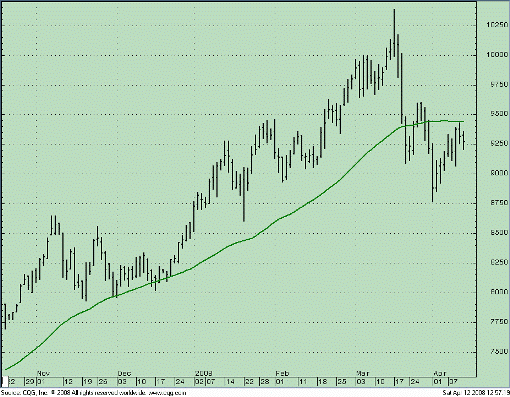
Source: Commodity.com
In contrast, here's a market that firmed last week and did manage to close above its 50-day average Friday, April 11.
July Cocoa
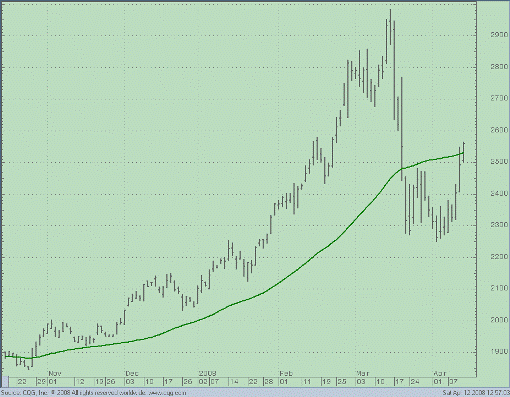
Source: Commodity.com
For the week, cocoa gained $285 a ton, while many other commodities appeared range bound. If you need a reason for the recent strength, the European Cocoa Association reported the first quarter cocoa grind was up nearly 5 percent. The major reason I require is that the market is currently trending up. This is one of the best reasons to buy July cocoa.
And although we're on the subject of the 50-day moving average--an indicator used by numerous trading funds--as of close Friday, April 11, here's how the following markets traded in relation to it.
Above the 50-day: cocoa, copper, corn, cotton, crude oil, euro, gasoline, natural gas, Treasury bonds and Japanese yen.
Below the 50-day: Canadian dollar, cattle, cotton, Dow Jones Industrial Average, gold, S&P 500, silver, soybeans, sugar and wheat.
The stock market indexes (the Dow Jones and S&P 500), precipitated by GE's poor earnings, turned below Friday.
Commodities trading below the 50-day but very close to turning above include May cotton, gold and soybeans. Note that cotton appears in both categories. The reason is the old crop (May) futures were trading just under the 50-day at press time, while the new crop (December) was trading well above. There's no coincidence here.
May Cotton (old crop)
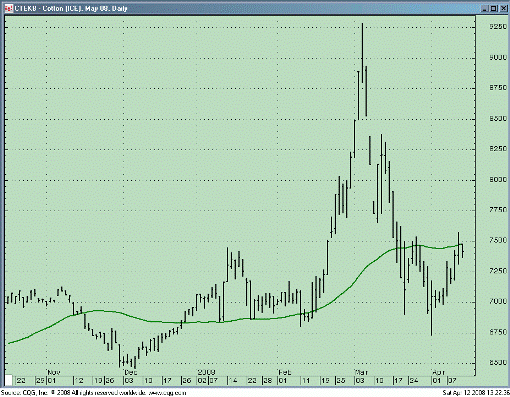
Source: Commodity.com
December Cotton (new crop)
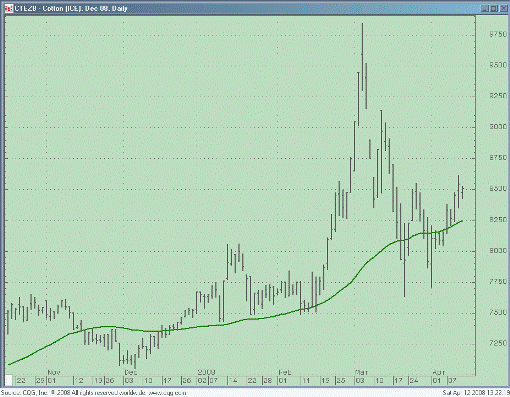
Source: Commodity.com
The cotton market is vulnerable to the sharp drop in planted acreage. Because of the high prices of competing crops such as soybeans and wheat, the projected planted acreage for cotton will be less than 9.5 million, the smallest number in 20 years. As a result, with absolutely no room for any adversity, the market will be very focused on weather this growing season. The recent break above the 50-day moving average for December cotton is a manifestation of a market transitioning into a bullish configuration.
May Soybeans
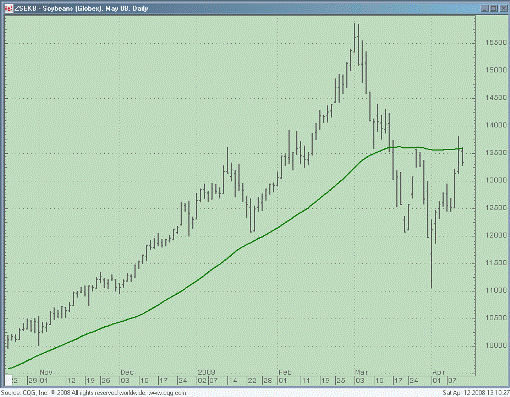
Source: Commodity.com
To clarify, I'm not suggesting solely relying on the 50-day moving average. A trader should never rely on just one indicator. Trading is complex, and prices are determined by innumerable variables.
However, at any one point in time, the market price is a consensus of all buyers and sellers. And the 50-day moving average is one quick-and-dirty means of trend determination.
Good luck, and good trading.
By George Kleinman
President
Commodity Resource Corp.
Lake Tahoe,
Nevada 89452-8700
http://www.commodity.com
George Kleinman is the President of the successful futures advisory and trading firm Commodity Resource Corp. (CRC). George founded CRC in 1983 while on the "floor" of the Minneapolis Grain Exchange to offer a more personalized level of service to traders. George has been an Exchange member for over 25 years. George entered the business with Merrill Lynch Commodities (1978 - 1983). At Merrill he attained the honor of 'Golden Circle' one of Merrill's top ten commodity brokers internationally. He is a graduate of The Ohio State University with an MBA from Hofstra University. George has developed his own proprietary trading techniques and is the author of three books on commodity futures trading published by the Financial Times.
He is Executive Editor of Futures Market Forecaster, a KCI Financial publication. In 1995, George relocated CRC to Nevada and today trades from an office overlooking beautiful Lake Tahoe. The firm assists individuals and corporate clients. CRC¹s exclusive clearing firm is R.J. O'Brien with all client funds held at RJO (assets in excess of $1.9 billion). Founded in 1914, R.J. O'Brien is a privately owned Futures Commission Merchant, and one of the most respected independent futures brokerage firms in the industry. RJO is a founding member of the Chicago Mercantile Exchange, a full clearing member of the Chicago Board of Trade, New York Mercantile Exchange, Commodity Exchange of New York and the New York Board of Trade. RJO offers the latest in order entry technology coupled with 24-hour execution and clearing on every major futures exchange worldwide. There is risk of loss when trading commodity futures and this asset class is not appropriate for all investors.
Risk Disclaimer
Futures and futures options can entail a high degree of risk and are not appropriate for all investors. Commodities Trends is strictly the opinion of its writer. Use it as a valuable tool, not the "Holy Grail." Any actions taken by readers are for their own account and risk. Information is obtained from sources believed reliable, but is in no way guaranteed. The author may have positions in the markets mentioned including at times positions contrary to the advice quoted herein. Opinions, market data and recommendations are subject to change at any time. Past Results Are Not Necessarily Indicative of Future Results.
Hypothetical Performance
Hypothetical performance results have many inherent limitations, some of which are described below. No representation is being made that any account will or is likely to achieve profits or losses similar to those shown. In fact, there are frequently sharp differences between hypothetical performance results and the actual results subsequently achieved by any particular trading program. One of the limitations of hypothetical performance results is that they are generally prepared with the benefit of hindsight. In addition, hypothetical trading does not involve financial risk, and no hypothetical trading record can completely account for the impact of financial risk in actual trading. For example, the ability to withstand losses or to adhere to a particular trading program in spite of trading losses are material points which can also adversely affect actual trading results. There are numerous other factors related to the markets in general or to the implementation of any specific trading program which cannot be fully accounted for in the preparation of hypothetical performance results and all of which can adversely affect actual trading results.
George Kleinman Archive |
© 2005-2022 http://www.MarketOracle.co.uk - The Market Oracle is a FREE Daily Financial Markets Analysis & Forecasting online publication.


